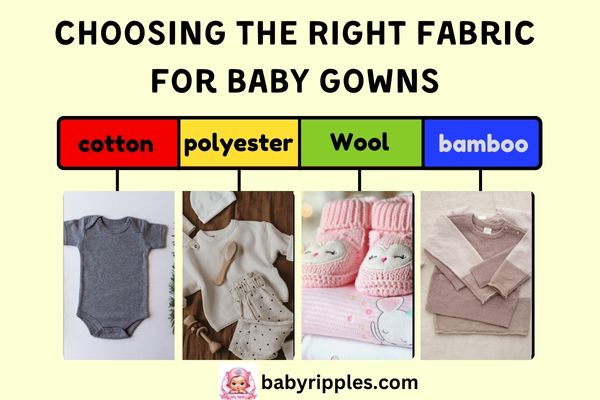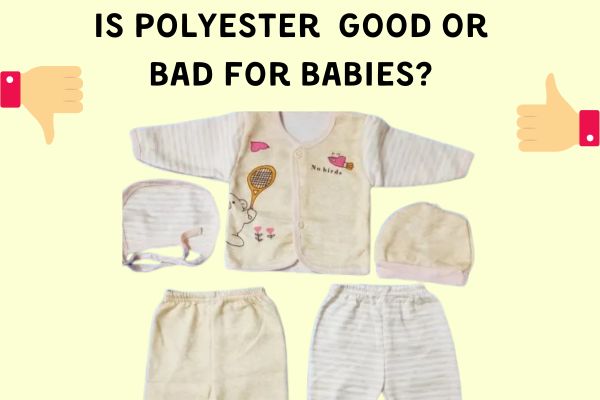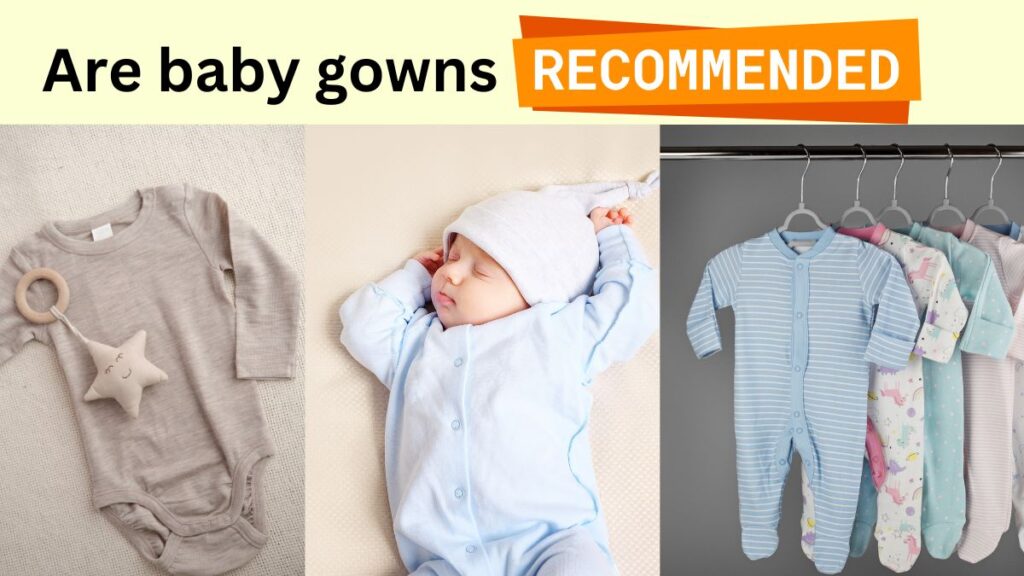Selecting the ideal clothing for your infant is an exciting, if occasionally daunting, undertaking. “Are baby gowns recommended?” is a question you may have. Yes, to put it simply! Due to their comfort, convenience, and ease of use, baby gowns have long been a favorite among parents. We’ll go over the advantages of baby gowns, their recommendations, and how to choose the best fabrics for your child’s comfort in this post.
In order to assist you make confident judgments, we’ll cover all the information you require regarding baby gowns, offer a temperature reference,address any concerns you may have regarding fabric safety and What to Dress Baby in for Sleep?
- What Are Baby Gowns, and Why Are They So Popular?
- Why Choose Baby Gowns? Key Benefits
- Choosing the Right Fabric for Baby Gowns
- Temperature Guide for Baby Clothes: Keeping Your Baby Comfortable
- Steps to Choose the Best Baby Gown for Your Little One
- Is Polyester Safe for Babies?
- Is Polyester Bad for Babies?
- When to Use Polyester Safely:
- Why Baby Gowns Are a Great Option for Newborn Sleep
- Caring for Your Baby’s Gowns
- Are Baby Gowns Recommended? Absolutely!
What Are Baby Gowns, and Why Are They So Popular?
A baby gown is basically a comfortable, one-piece garment with an open bottom. Typically, it features tie or elastic fastenings at the bottom, which eliminates the need to fiddle with buttons, zippers, or snaps when changing diapers. This design is very handy for babies who need to change their diapers frequently.
Although they can be worn by older infants if they fit and are comfortable, baby gowns are usually advised for newborns up to three months of age.
Why Choose Baby Gowns? Key Benefits

1: Simple Changes for Diapers Diaper changes are a breeze with baby dresses. You can rapidly change diapers with the open bottom without completely undressing your kid. The convenience is unrivaled, whether you’re out and about or in the middle of the night.
2: Cozy and spacious Babies may move freely in baby gowns since they fit loosely around the body, which is perfect for their growing muscles. Gowns allow newborns to stretch and kick comfortably, unlike pants or other constricting apparel.
3: Perfect for Stacking Layering is crucial for controlling your baby’s body temperature, and baby gowns are ideal for this. “Is polyester safe for babies?” is a question that many parents have. Because of its cost and durability, polyester is frequently used in infant clothes; yet, it could not breathe as well as natural fabrics like cotton. Prioritizing breathable materials that won’t overheat your infant is a smart option when layering.
4: Excellent for Contact with the Skin In order to foster bonding through skin-to-skin contact, many parents choose to wear gowns or skin-to-skin onesies. Parents can easily keep their infant near without interfering with this crucial bonding time because to the gown’s straightforward design.
Choosing the Right Fabric for Baby Gowns

Selecting the right material is crucial, as babies have sensitive skin that can react to harsh or synthetic fabrics. Here’s a rundown of the most common fabrics and whether they’re suitable for baby gowns.
1. Cotton
Cotton is a popular material for infant clothes since it is hypoallergenic, breathable, and soft. Your infant will stay warm without overheating because to cotton’s ability to retain heat. Because organic cotton is free of chemicals and pesticides, it is safer for sensitive skin, which is why many parents choose it.
2. Wool from Merino
Merino wool is renowned for its ability to regulate body temperature, keeping infants cool in the summer and warm in the winter. Merino wool thermal baby clothes are particularly well-suited for colder locations. Wool, however, may need more sensitive care and might be expensive.
3. Polyester
Although polyester is reasonably priced and long-lasting, it’s not always the best option for babies, particularly when it comes to extended wear. Polyester can trap heat and cause discomfort for newborns because it doesn’t breathe as effectively as natural fabrics. Polyester may be safe for short-term use or for certain types of clothes (such as outer layers), but make sure to combine it with breathable materials.
4. Bamboo
Bamboo cloth offers moisture-wicking qualities, is silky, and is hypoallergenic by nature. Although it can be more expensive than other materials, it’s a fantastic choice for infants with delicate skin.
Temperature Guide for Baby Clothes: Keeping Your Baby Comfortable
One of the biggest challenges for new parents is figuring out how to dress their baby to keep them comfortable in different temperatures. Here’s a temperature guide for baby clothes to help you out:
• 75°F and Up: A breezy dress or onesie composed of breathable materials, such as cotton, is typically sufficient in warm weather. Steer clear of polyester since it retains heat.
• Between 70°F and 75°F, a lightweight babygown with a thin blanket or swaddle should be ideal. To prevent your baby from overheating, it is advised to use cotton or bamboo textiles.
• 65°F to 70°F: Put on a heavier gown made of materials like merino wool or a thermal onesie for your infant. It’s also an excellent idea to layer with a lightweight sleep sack or swaddle.
• Below 65°F: Use warm baby clothes, such as a fleece or wool robe, in cooler climates, layering as necessary. To keep your infant warm, always keep their hands and feet covered.
Steps to Choose the Best Baby Gown for Your Little One
1. Pick the Proper Size Newborns usually wear one-size-fits-all baby gowns, but it’s important to make sure the fit is flexible. To keep the robe snug around your baby’s feet, look for gowns with bottom closures.
2. Give Breathable Fabrics Priority As previously said, because polyester isn’t very breathable, it might not be the greatest choice for infant gowns. To keep a pleasant temperature, natural fibers like cotton, bamboo, or merino wool are recommended.
3. Take the climate and season into account Select a material appropriate for the time of year. Choose light cotton for the summer and merino wool or another thermal newborn apparel option for the winter to keep your baby warm.
4. Examine the ease of care. Because newborns can be dirty, choose fabrics that are both easily cleaned and strong enough to resist repeated washings.
5. Prioritize safety Steer clear of dresses with loose threads, tiny buttons, or other embellishments that could cause choking hazards.
Polyester is commonly used in baby clothes due to its durability and affordability, but many parents wonder about its safety. Here’s a closer look at the pros and cons of using polyester for babies:
Is Polyester Safe for Babies?

In general, polyester is regarded as safe for infants, particularly when it is used in outer layers like blankets or coats that don’t come into contact with their skin for extended periods of time. When it comes to baby clothes, its durability, resistance to wrinkles, and ability to withstand multiple washings can be advantageous. To increase comfort and breathability, polyester is frequently combined with different fibers in infant clothing.
The main issue with polyester, though, is that it doesn’t breathe as well as natural textiles like cotton or bamboo. Babies who wear polyester for extended periods of time, particularly in warm weather or while sleeping, may overheat.
Is Polyester Bad for Babies?
Polyester isn’t always “bad” for babies, but it’s not always the best option. Because polyester is synthetic, it doesn’t wick moisture as well, which might cause discomfort if a baby perspires. Additionally, polyester may aggravate eczema or cause discomfort to your baby’s sensitive skin.
When to Use Polyester Safely:
Layering: Blend polyester with natural textiles or use it in outer layers.
Seasonal Wear: To avoid overheating in warm weather, stay away from polyester sleepwear and full-body clothing.
Comfort Check: Always make sure your infant feels at ease wearing synthetic clothing; if not, natural materials are preferable.
Breathable materials like cotton, bamboo, and wool are frequently suggested for daily use in order to assist your baby be comfortable and regulate their body temperature.
Why Baby Gowns Are a Great Option for Newborn Sleep
Since newborns sleep for extended periods of time, comfort is essential. Baby gowns make it simple to change a baby’s diaper at night, allowing parents to care for their child without creating too much of a disturbance.
Baby gowns are a great option for those seeking a comfortable and practical solution that will ensure a restful night’s sleep. Just keep in mind that babies are less adept at controlling their body temperature, so layering is important.
Caring for Your Baby’s Gowns
To make the most out of your baby’s clothing, proper care is key. Here are some quick tips:
• Pay Close Attention to Labels:
Baby clothes frequently need to be washed gently. Certain textiles, like bamboo or wool, can require hand washing or gentle cycle washing.
• Use Mild Detergents:
Due to their sensitive skin, babies should only use detergents that are devoid of dyes and fragrances.
• Steer clear of high heat drying:
Cotton and bamboo, for example, might shrink when exposed to high heat. Baby gowns should ideally be air-dried or tumble-dried on low.
Are Baby Gowns Recommended? Absolutely!
Ultimately, it should be noted that baby gowns are a great choice for newborns and infants. They are comfortable to wear, ideal for frequent diaper changes, and straightforward to use. As you choose, just keep in mind to look at the material, make sure it’s breathable, and keep in mind the baby clothing temperature guide.
Are you ready to buy baby dresses? Seek out premium, breathable materials and pick solutions that will offer comfort, security, and longevity. You can choose cotton, bamboo, or wool, and your baby will be surrounded by love and warmth. Baby gowns are more than simply clothing; they’re the ideal means of keeping your child content and comfortable.
1. Is polyester safe for babies?
Polyester is safe in small doses but may not be ideal for prolonged wear, especially in sleepwear, as it lacks breathability.
2. Are baby gowns suitable for all seasons?
Yes, baby gowns are suitable for all seasons when made from the right materials. Cotton is great for summer, while wool or thermal infant clothing is excellent for winter.
3. What fabrics are best for baby gowns?
Natural fibers like cotton, merino wool, and bamboo are recommended for their breathability and softness.
4. How do I layer a baby gown in winter?
In colder months, pair a baby gown with a cozy swaddle or sleep sack to keep your baby warm without overheating.





